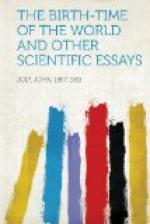Many more such cases might be cited. The heating of india-rubber when expanded, its cooling when compressed, is a remarkable one; for at first sight it appears as if this must render it exceptional to the general law, most substances exhibiting the opposite thermal effects when stressed. However, here, too, the action of the stress is opposed by the secondary effects developed in the substance; for it is found that this substance contracts when heated, expands when cooled. Again, ice being a substance which contracts in melting, the effect of pressure is to facilitate melting, lowering its freezing point. But
64
so soon as a little melting occurs, the resulting liquid calls on the residual ice for an amount of heat equivalent to the latent heat of liquefaction, and so by cooling the whole, retards the change.
Such particular cases illustrate a principle controlling the interaction of matter and energy which seems universal in application save when evaded, as we shall see, by the ingenuity of life. This principle is not only revealed in the researches of the laboratory; it is manifest in the history of worlds and solar systems. Thus, consider the effects arising from the aggregation of matter in space under the influence of the mutual attraction of the particles. The tendency here is loss of gravitational potential. The final approach is however retarded by the temperature, or vis viva of the parts attending collision and compression. From this cause the great suns of space radiate for ages before the final loss of potential is attained.
Clerk Maxwell[1] observes on the general principle that less force is required to produce a change in a body when the change is unopposed by constraints than when it is subjected to such. From this if we assume the external forces acting upon a system not to rise above a certain potential (which is the order of nature), the constraints of secondary actions may, under certain circumstances, lead to final rejection of some of the energy, or, in any
[1] Theory of Heat, p. 131.
65
case, to retardation of change in the system—dissipation of energy being the result.[1]
As such constraints seem inherently present in the properties of matter, we may summarise as follows:
The transfer of energy into any inanimate material system is attended by effects retardative to the transfer and conducive to dissipation.
Was this the only possible dynamic order ruling in material systems it is quite certain the myriads of ants and pines never could have been, except all generated by creative act at vast primary expenditure of energy. Growth and reproduction would have been impossible in systems which retarded change at every step and never proceeded in any direction but in that of dissipation. Once created, indeed, it is conceivable that, as heat engines, they might have dragged out an existence of alternate life and death; life in the hours of sunshine, death in hours of darkness: no final death, however, their lot, till their parts were simply worn out by long use, never made good by repair. But the sustained and increasing activity of organized nature is a fact; therefore some other order of events must be possible.




